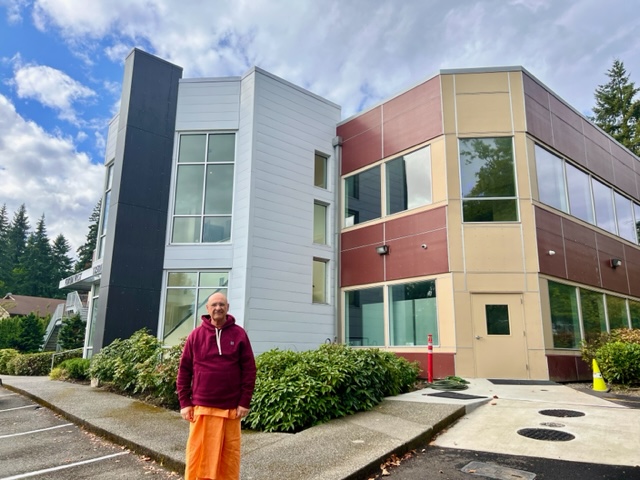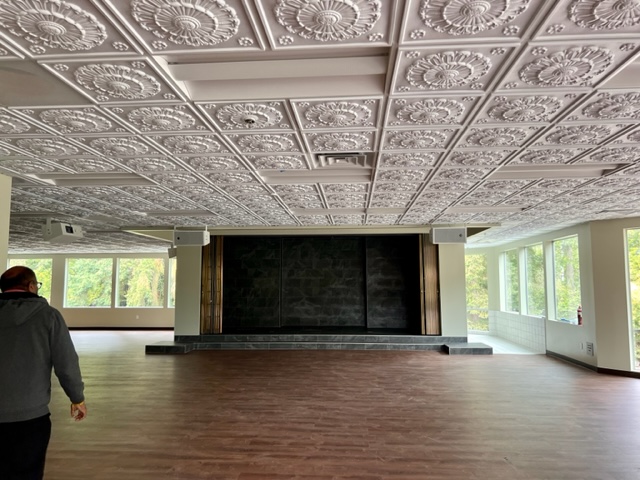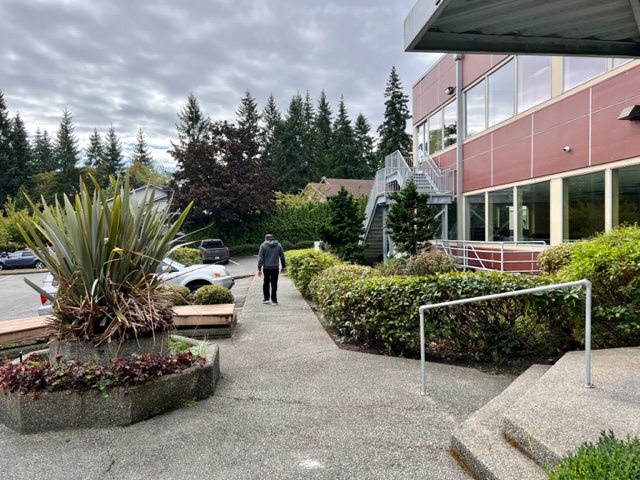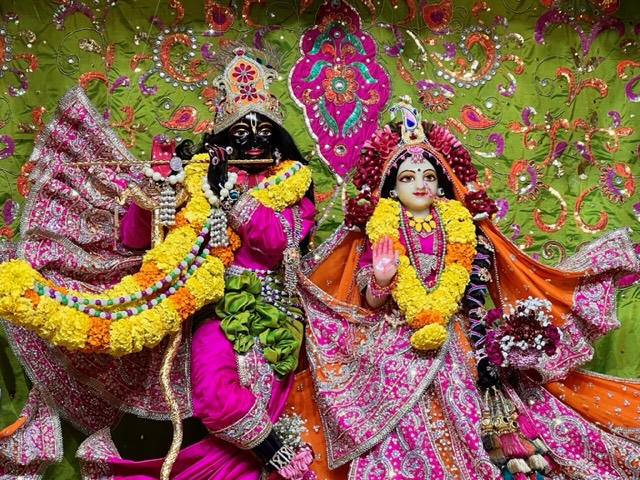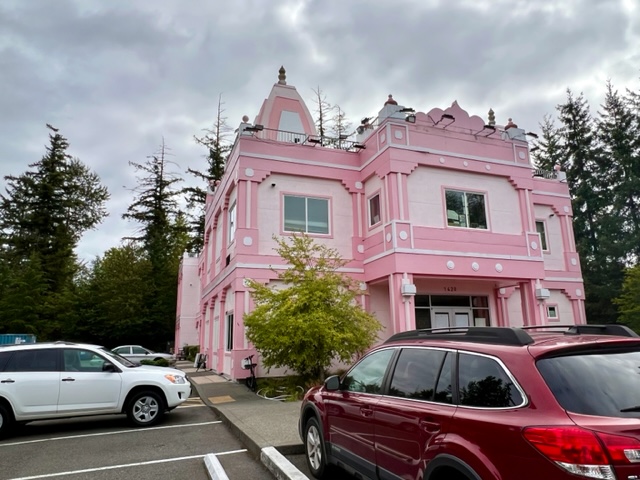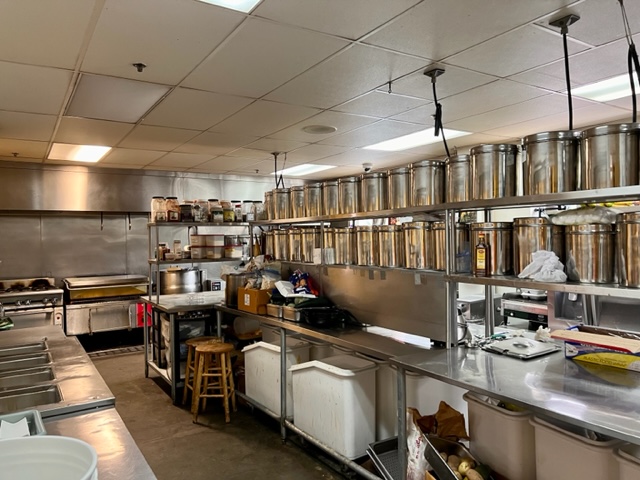The glories of Sridhama Mayapur are unlimited and inconceivable, as it is the abode of Sri Caitanya Mahaprabhu and His associates wherein “the concluding portions of the pastimes of Gokula exist eternally as the pastimes of Navadvipa.” (Brahma-samhita 5.5). In this divine realm the Lord tastes love of Godhead Himself in the mood of Srimati Radharani, as further explained in the same Brahma-samhita purport by Srila Bhaktisiddhanta Sarawati:
“Goloka as Svetadvipa is eternally manifest because the pleasures of enjoyment of the rasa could not be had in its entirety in the pastimes of Krishna in Vraja. He accepts the emotion and effulgence of His predominated moiety, Sri Radhika, and makes an eternal pastime for the enjoyment of Krishna-rasa there. Sri Krishnachandra coveting to taste the following pleasures, viz., to realize (1) the nature of the greatness of love of Sri Radha; (2) the nature of the wonderful sweetness of His love of which Sri Radha has got the taste; (3) the nature of the exquisite joy that accrues to Sri Radha by Her realization of the sweetness of His love, took His birth, like the moon, in the ocean of the womb of Sri Saci-devi.”
One might well ask, what is Srimati Radharani’s direct part in these ‘concluding pastimes of Gokula’? What is Navadvipa’s relationship to her? We can find the answer by diving deeper into the esoteric nature of the Lord and His loving exchanges with His hladini sakti, pleasure potency, Sri Radha, in this narration by Lord Siva to Parvati in the Ananta-samhita, presented by HH Bhakti Purushottama Swami in his book, The Glories and Pastimes of Srimati Radharani.
The Wonderful Glories of Sridham Mayapur
Sri Mayapur-dhama, however, was Srimati Radharani’s own creation, to lure Krishna away from another lover. In the Ananta-samhita, Siva explains to Parvati why Srimati Radharani created merciful Sri Mayapur-dhama.
Lord Siva told Parvati, “As a bee plays in a lotus, Krishna was enjoying with Viraja in the pleasant forest groves of Vrndavana. Moon-faced, doe-eyed Radhika heard this news from one sakhi and hastily ran to find Krishna. Seeing that Radha was coming, Krishna suddenly disappeared and Viraja became a river. When Srimati Radharani arrived there, She could not find them. Absorbed in thoughts of Krishna, Radha began to think of how to attract Him away from Viraja. She gathered her sakhis together between the Ganga and Yamuna Rivers.
“She created a beautiful place, decorated with creepers and trees and filled with male and female bumblebees. Deer and bucks were happy enjoying as they wandered about, and the whole area was filled with the fragrance of jasmine, mallika, and malati flowers. That transcendental abode was adorned with tulasi forests and decorated with various groves. On Radha’s order, the Ganga and Yamuna, with their pleasant water and banks, acted as a moat to protect the garden. Cupid himself, along with springtime, eternally resides there, and the birds constantly sing the auspicious name of Krishna.
“Radha, dressed in colorful cloth, then began to play a beautiful melody on a flute in order to attract Krishna. Attracted by that melody, Krishna appeared in that enchanting place. Radha, the attractor of Krishna’s mind, seeing that Krishna had come, held His hand and experienced ecstatic delight. Then Krishna, understanding Radha’s mood, spoke in a voice choked with love.
‘O lovely-faced Radha, You are My very life. There is no one more dear to Me than You. Therefore, I will never leave You. Just for Me You have created this wonderful place. Staying with You, I will transform this place, filling it with new sakhis and groves. The devotees will glorify this place as New (nava) Vrndavana. As this place is like an island (dvipa), the wise will call it Navadvipa. By My order, all the holy places will reside here.
‘Because You have created this place for My pleasure, I will live here eternally. Those people who come here and worship us will eternally attain our eternal service in the mood of the sakhis. O dear Radha, like Vrndavana, this place is extremely pure. If anyone comes here just once, he will obtain the results of going to all sacred places. He will quickly attain devotional service, which satisfies us.’
“O Parvati,“ Lord Siva continued, “I have described to you the reason for the appearance of Navadvipa. When heard by mankind, this narration removes all sins and bestows devotional service. Whoever rises early in the morning and with devotion to Gaura recites or hears this story of Navadvipa’s creation will certainly attain Gauranga.”
The Temple of the Vedic Planetarium (TOVP) rising in Sridham Mayapur is a further manifestation and expansion of the glories of this most sacred abode. As Sri Krishna said to Radhika in the above narration, “Staying with You, I will transform this place, filling it with new sakhis and groves.” This indicates the Lord’s appearance as His most munificent and merciful incarnation of Sri Caitanya:
“The Lord’s desire to appear was born from two reasons: He wanted to taste the sweet essence of the mellows of love of God, and He wanted to propagate devotional service in the world on the platform of spontaneous attraction. Thus He is known as supremely jubilant and as the most merciful of all.”
(CC Adi-lila 5.15-16)
The TOVP will be instrumental in “filling it (Navadvipa) with new sakhis and groves”. New sakhis means from the conditioned souls here in the material world. And for the next 10,000 years the Hare Krishna movement will help the Lord fulfill His promise. And we can receive the benefit of assisting in this transcendental pastime by building the TOVP which will bring hundreds and thousands of people to Krishna consciousness.
At the 2024 Gaura Purnima festival in Mayapur, from February 29 – March 2, we will be opening the completed Nrsimhadeva Wing in the TOVP, the largest Nrsimha Temple in the world. You can help by sponsoring a Nrsimha Brick with your name inscribed and placed under the Lord’s altar or one of many other options. Go to the Give To Nrsimha Campaign page on the TOVP website TODAY and take advantage of this once-in-a-lifetime opportunity.
A Miracle in the Making ~ Home of Our Divine Protector
TOVP NEWS AND UPDATES – STAY IN TOUCH
Visit: www.tovp.org
Support: https://tovp.org/donate/
Email: tovpinfo@gmail.com
Facebook: www.facebook.com/tovp.mayapur
YouTube: www.youtube.com/c/TOVPinfoTube
Twitter: https://twitter.com/TOVP2022
Telegram: https://t.me/TOVP_GRAM
WhatsApp: https://chat.whatsapp.com/LQqFCRU5H1xJA5PV2hXKrA
Instagram: https://m.tovp.org/tovpinstagram
App: https://m.tovp.org/app
News & Texts: https://m.tovp.org/newstexts
RSS News Feed: https://tovp.org/rss2/
Store: https://tovp.org/tovp-gift-store/
